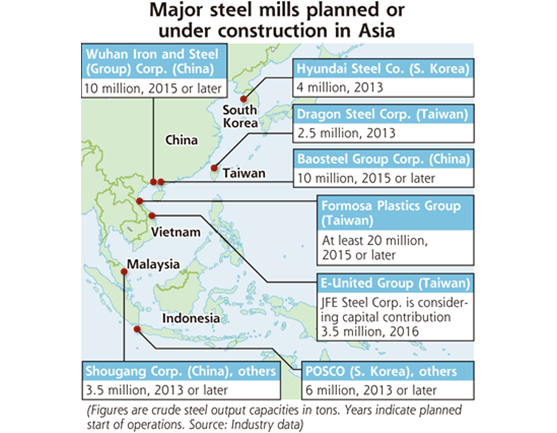Product
January 18, 2013
Asian Boom in Steel Mill Construction
Written by Sandy Williams
Written by: Sandy Williams
At least eight new steel plants are under construction in Asia (not including India) that will increase the annual output capacity of steel in Asia by 100 million tonnes within the next few years. Currently China accounts for nearly 50 percent of global steel demand with its own annual output capacity at 900 million tonnes–already 200 million more tonnes than their demand requires.
South Korea’s POSCO, along with Chinese steelmakers, plans to build mills in at least five locations in Southeast Asia with output capacities of 3 million to 20 million tonnes each.
POSCO and Krakatau Steel are building an integrated steel mill in Cilegon, Banten in Indonesia that is expected to have a 3 million tonnes production capacity in the first phase and double in the second. Products will include slab, plate, and hot rolled coil.
China’s state-owned steelmaker Shougang Group is building a steel slab plant in Malaysia to produce 1.5 million tonnes of steel annually.
JFE Steel with E-United Group is working on a steelworks in Vietnam with an annual capacity of 3.5 million tonnes, consisting mainly of steel sheets, to be completed in 2016.
Formosa Ha Tinh Steel is planning a steel mill complex with three blast furnaces to be completed in the Ha Tinhi province in Vietnam between 2015 and 2017. The complex is expected to have an annual output capacity of 22 million tonnes.
China Steel Group is adding a second furnace to its Dragon Steel facility in Taiwan that is expected to have an annual capacity of 2.5 million tonnes when it begins operation in 2013. Dragon Steel manufactures slab, long products and hot and cold rolled steel.
Hyundai Steel Co. will add 4 million tonnes of output capacity of rolled steel following completion of a third blast furnace in Dangjin, South Korea, raising the facilities total output to 12 million tonnes, bringing its domestic capacity to 24 million tonnes.
Wuhan Iron and Steel Group Corp. is constructing a steel mill in Fangcheng, China and Baosteel Group Corp. is building a similar size facility in Zhanjiang. Both facilities will have an annual output capacity of 10 million tonnes of high end sheet capacity in the first phase and a total capacity of 30 million tonnes for Fangcheng and 20 million tonnes for Zhanjiang in the future.
POSCO SS-VINA in Vietnam is scheduled to be completed in 2014. It will include a steel manufacturing plant and a rolling mill which will have an annual production capacity of 1 million tonnes of shape steel, steel reinforcement and bar steel.
The potential increase in Asian capacity has steelmakers in Japan worried. Crude steel output in Japan has been almost flat for nearly 40 years at 100 million tonnes per year. High-quality sheet steel, mainly for automobiles, has given Japanese makers an advantage over area rivals but improvement in quality has been rising in Korea and China. (Source: The Daily Yomiuri)








